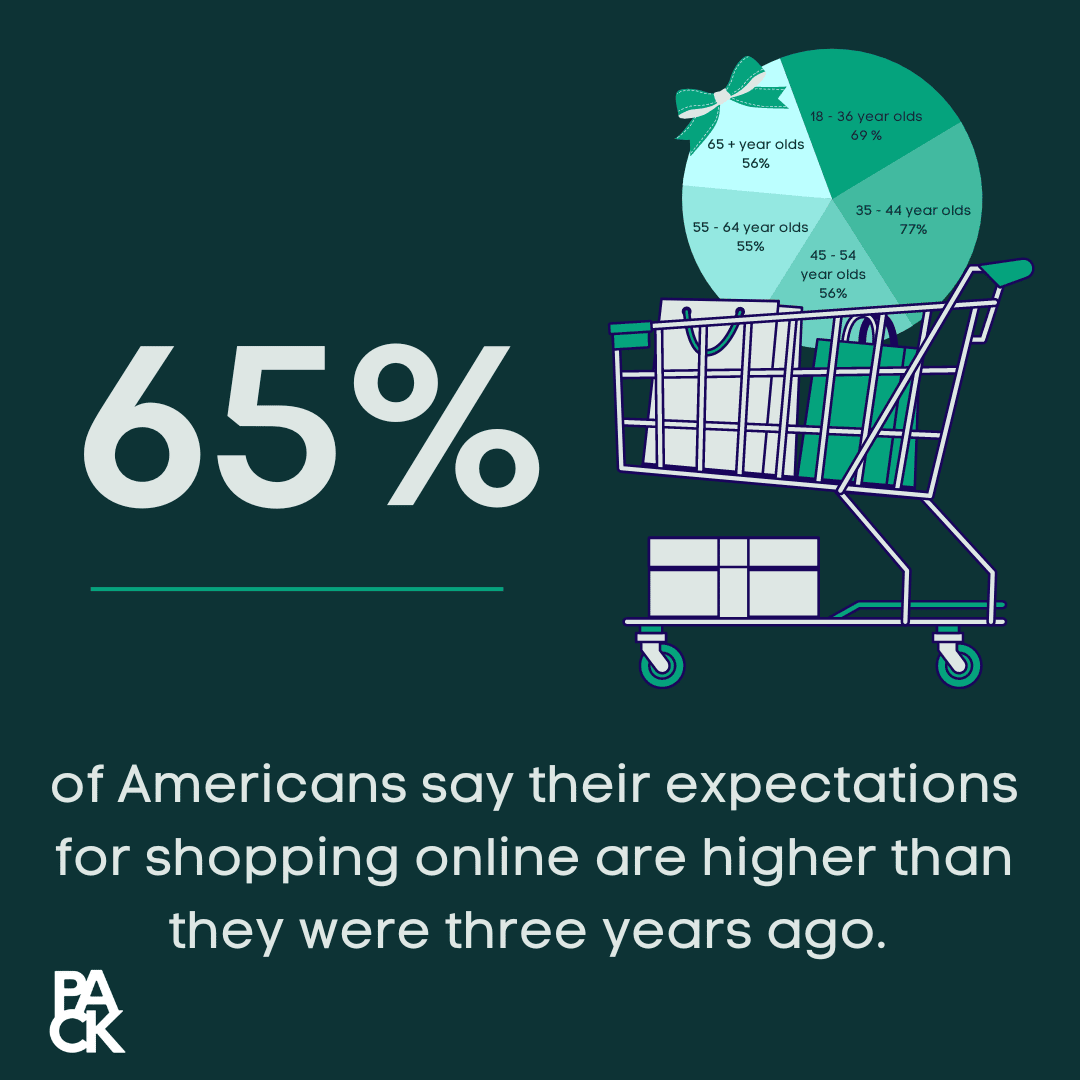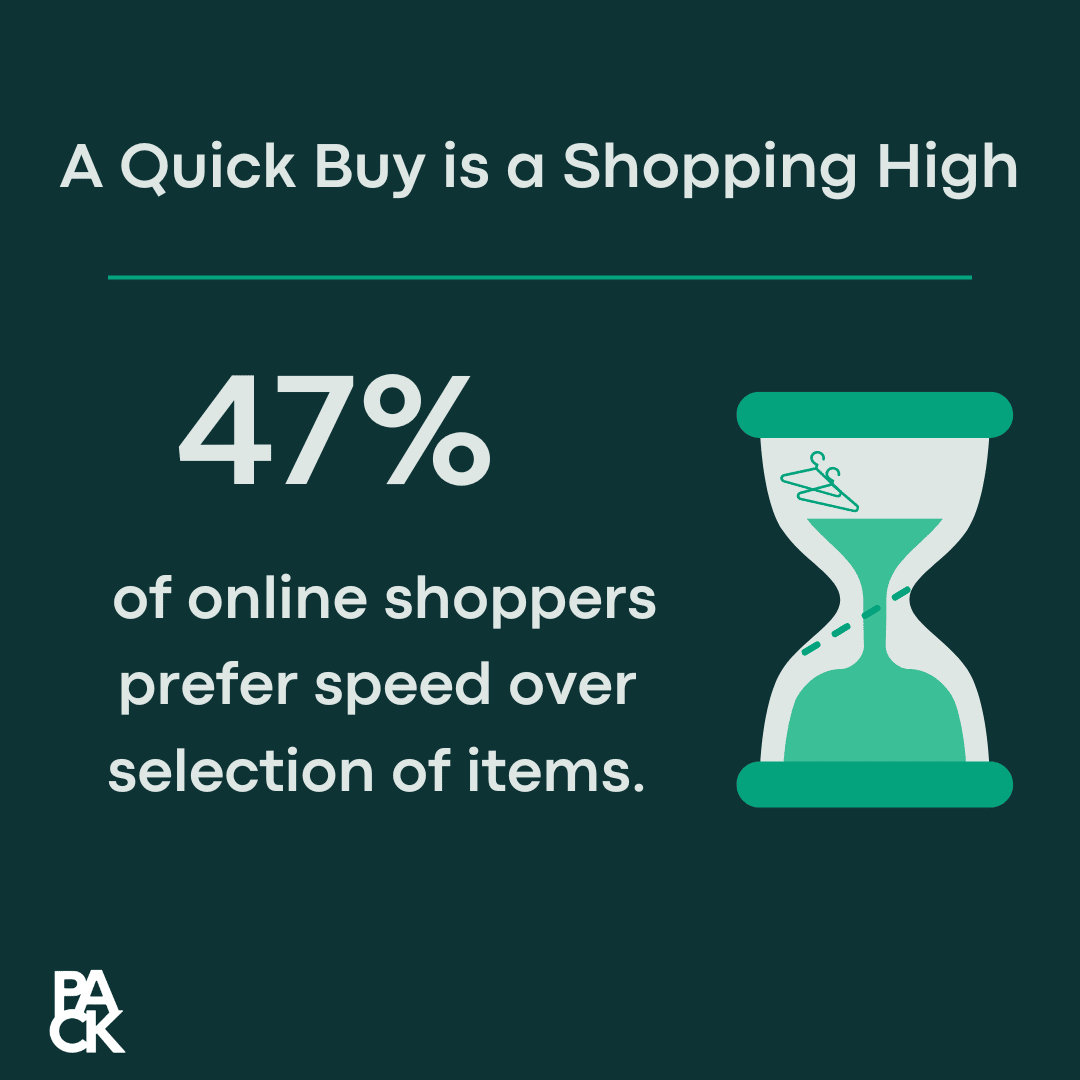As consumer expectations continue to skyrocket, so too does their need for digital shopping speed—nearly one-half of U.S. online shoppers now say it’s more important for them to be able to buy something quickly than it is to have a large selection of items to choose from, according to new research from headless commerce solution Pack.
The firm’s inaugural eCommerce Trends Report, with research partner Harris Poll, also illustrates the impact website speed and ease of use have on consumers’ path to purchase and brand loyalty, with many shoppers saying they’ll turn to competitors if they can’t find what they need after one (fruitless) search, or if a site takes too long to load. Perhaps most surprising, almost one third of shoppers said they’d be willing to wait up to three days longer to receive an item if they had an easier and faster shopping experience.
“It’s important that brands understand what drives shoppers to the cart and keeps them coming back. Consumers shouldn’t have to make sacrifices for speed, just as retailers shouldn’t have to surrender the sale due to slow loading times on their site,” said Cory Cummings, CEO and co-founder of Pack, in a news release. “Our findings show that the seamless, one-click experience consumers expect when shopping on social media is quickly becoming the norm for online purchases overall—making eCommerce brands that prioritize efficiency and speed well-positioned to win out in the busy holiday season, and beyond.”
Converging with changing consumer behaviors amid surging eCommerce adoption during the pandemic is the abandonment of brand loyalty
McKinsey data shows more U.S. consumers are switching retailers and brands now than in 2020 and 2021, citing convenience and value. With the majority of Americans (65 percent) saying their online shopping expectations are greater now than they were pre-pandemic, findings also show that demand for experiences resembling the simplicity of social media shopping are on the rise, particularly for those aged 18-34.
Findings include:
Speed over sparkle
A quick buy is a shopping high: Almost half (47 percent) of online shoppers prefer speed over selection of items. This is especially true for Gen Z and Millennials, with 57 percent of both 18-34 and 35-44 year olds agreeing that the ability to buy quickly is more important than having a variety of items to choose from.
Two-thirds (66 percent) of Americans would be willing to make sacrifices for a speedy purchase process, with almost one third (32 percent) willing to wait at least three days longer on shipping to receive the item.
Overall, 65 percent of Americans say their expectations for shopping online are higher than they were three years ago. This percentage spikes to 77 percent for shoppers ages 35-44.
Searcher beware: Two-thirds of shoppers will look for an item on a competitor’s website if they can’t find what they are looking for after one search. If a website takes too long to load, 55 percent of shoppers will look to make a purchase elsewhere—a figure that jumps to 62 percent for ages 18-34 and 63 percent for 35-44 year olds.
Social-savvy shoppers’ purchasing preferences
A third (34 percent) prefer shopping experiences that remind them of social media experiences, which increases to 55 percent for those aged 18-34.
Almost half of Americans (43 percent) believe buying items online straight from social media is easy; more digitally-native generations agree (54 percent of those 18-34, 56 percent of those 35-44).
Modern direct to consumer businesses that prioritize speed and efficiency are benefiting from the social shopping trend and seeing increased sales and customer loyalty from key demographics:
Three in 10 (30 percent) of shoppers aged 18-34 would actually forgo buying items from a big box retailer in favor of ecommerce sites with a quicker path to purchase. One quarter of both 35-44 and 45-54 year olds agree. 44 percent of both 18-34 and 35-44 year olds say they have bought more from independent brands this year than last. Within the same age ranges, 40 percent of men are buying more from independent retailers in 2022 than 2021, compared to 22 percent of women.
Buyer behavior: Cart caching, “spirited” shopping, and more
While adding items to an online shopping cart typically signals intent to buy, it could also indicate a lack of functionality that consumers crave from eCommerce sites. Two-thirds (64 percent) of Americans say they actually use the shopping cart as a bookmark to save items for the future. Roughly one quarter of Americans (23 percent) have bought something online between midnight and 5 A.M.
Fifteen percent of Americans say they’ve made a purchase while in bed with their significant other. While more women than men fess up to this (16 percent v. 14 percent), more men than women admit to making an online purchase under the influence of alcohol (10 percent v. 8 percent). Parents with children at home admitted to all of these online shopping behaviors more than any other demographic.
This survey was conducted online within the United States by The Harris Poll on behalf of Pack from Oct 4-6, 2022 among 2,068 U.S. adults ages 18+. The sampling precision of Harris online polls is measured by using a Bayesian credible interval. For this study, the sample data is accurate to within +/- 2.8 percentage points using a 95% confidence level.






